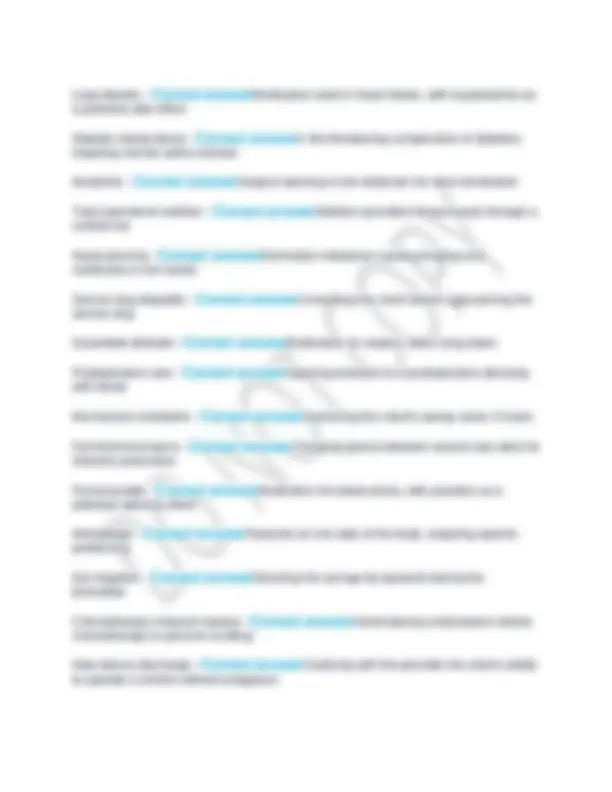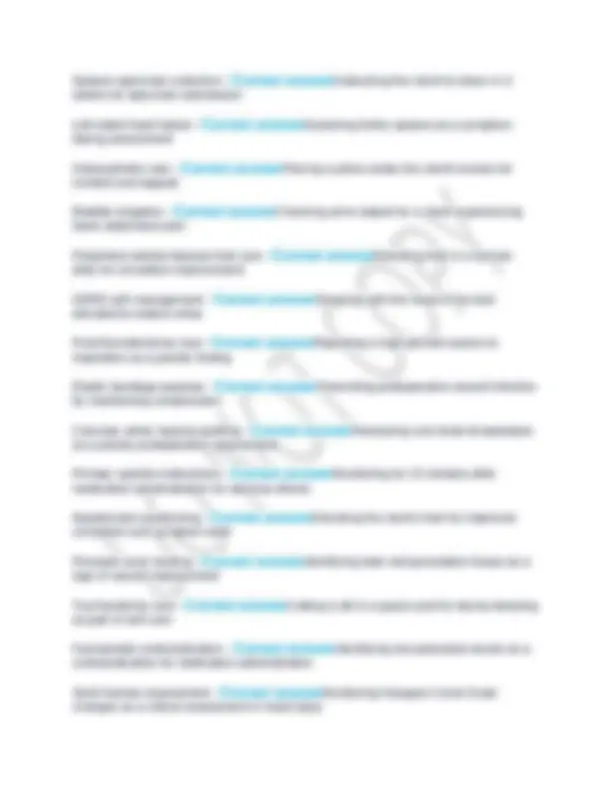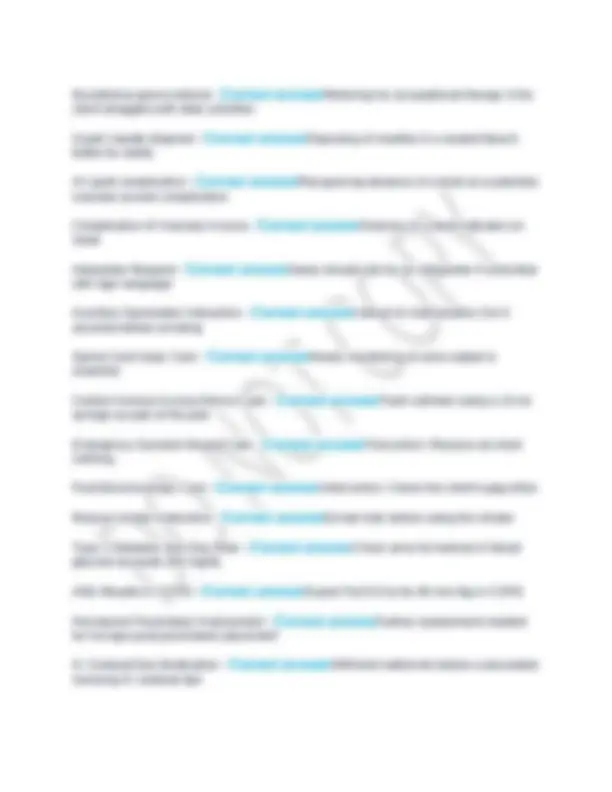Download ATI RN Medical-Surgical Proctored Exam 2019 Retake Q&A Update 2025,. and more Exams Nursing in PDF only on Docsity!
ATI RN Medical-Surgical Proctored
Exam 2019 Retake Q&A Update 2025,.
Acupuncture Contraindication - Correct answer Lymphedema is a contraindication
for acupuncture in chemotherapy patients.
IV Infusion Calculation - Correct answer Calculating 33 gtt/min for lactated Ringer's
with 10 drops/mL IV tubing.
Sublingual Nitroglycerin Teaching - Correct answer Client understanding indicated
by 'I should lie down when taking this medication.'
Total Hip Arthroplasty Instruction - Correct answer Include 'Install a raised toilet seat'
in discharge teaching for older adult clients.
Cardiac Catheterization Care - Correct answer Maintain the affected extremity in
extension post-cardiac catheterization.
Role Adaptation - Correct answer Client adapting to role change by delegating
grocery shopping and cooking.
Immune System Teaching - Correct answer Teach to wash peri area twice daily with
antimicrobial soap for chemo patients.
Thirst and Urinary Output - Correct answer 4,000 ml output may lead to
desmopressin prescription for client with contusion.
ACE Inhibitor Side Effect - Correct answer Suggest lozenge for nagging dry cough in
a client on ACE inhibitor therapy.
Raynaud's Disease Trigger - Correct answer Nicotine patch use can exacerbate
Raynaud's disease in clients.
Central Venous Device Disconnection - Correct answer In case of disconnection,
place the client on the left side in Trendelenburg position.
Skin Integrity Intervention - Correct answer Support bony prominences with pillows
for a client with reddened areas over bony prominences.
Multiple Sclerosis Priority Action - Correct answer Prioritize listing coping strategies
for family dealing with role changes in MS client.
Colorectal Cancer Risk Factor - Correct answer History of Crohn's disease increases
the risk of colorectal cancer.
Client's Mastectomy Concern - Correct answer Offer additional information about the
mastectomy procedure to the client.
Packed RBCs Transfusion Steps - Correct answer Sequence: venous access, obtain
RBCs, verify compatibility, initiate transfusion, monitor client.
Modified Radical Mastectomy Teaching - Correct answer Expect less than 25 ml
drainage per day in teaching for post-mastectomy care.
Glasgow Coma Scale Scoring - Correct answer Assign a score of 5 for a client with
decerebrate posturing and incomprehensible sounds.
Heart Failure Sodium Intake - Correct answer Client understands teaching if they
mention having a frozen fruit juice bar for dessert.
Ocular Irrigation Priority - Correct answer First action: instill 0.9% sodium chloride
solution into the affected eye post-chemical splash.
Extubation Complication - Correct answer Immediate intervention needed for stridor
post-extubation in a ventilated client.
Acute Pancreatitis Finding - Correct answer Expect elevated blood glucose in a
client with acute pancreatitis.
Diabetes Insipidus Finding - Correct answer Urine specific gravity of 1.001 is
expected in a client with diabetes insipidus.
Pulmonary Embolism Intervention - Correct answer Initiate continuous IV heparin
infusion for a client with a pulmonary embolism.
Sickle Cell Crisis Instruction - Correct answer Instruct to avoid extreme temperatures
during recovery from a sickle cell crisis.
Hypovolemic Shock Management - Correct answer First action: Insert a large-bore
IV catheter for a client in hypovolemic shock.
Large-bore IV catheter - Correct answer A type of IV catheter with a wide diameter
for rapid fluid administration
Palpable thrill - Correct answer A vibration felt over an arteriovenous graft, indicating
adequate circulation
Sputum specimen collection - Correct answer Instructing the client to return in 2
weeks for specimen submission
Left-sided heart failure - Correct answer Expecting frothy sputum as a symptom
during assessment
Osteoarthritis care - Correct answer Placing a pillow under the client's knees for
comfort and support
Bladder irrigation - Correct answer Checking urine output for a client experiencing
lower abdominal pain
Peripheral arterial disease foot care - Correct answer Elevating feet in a recliner
daily for circulation improvement
GERD self-management - Correct answer Sleeping with the head of the bed
elevated to reduce reflux
Post-thyroidectomy care - Correct answer Reporting a high-pitched sound on
inspiration as a priority finding
Elastic bandage purpose - Correct answer Preventing postoperative wound infection
by maintaining compression
Coronary artery bypass grafting - Correct answer Measuring core body temperature
as a priority postoperative assessment
Primary syphilis instructions - Correct answer Monitoring for 15 minutes after
medication administration for adverse effects
Hypotension positioning - Correct answer Elevating the client's feet for improved
circulation and symptom relief
Pressure ulcer healing - Correct answer Identifying dark red granulation tissue as a
sign of wound improvement
Tracheostomy care - Correct answer Cutting a slit in a gauze pad for stoma dressing
as part of self-care
Furosemide contraindication - Correct answer Identifying low potassium levels as a
contraindication for medication administration
Skull fracture assessment - Correct answer Monitoring Glasgow Coma Scale
changes as a critical assessment in head injury
Myasthenia gravis referral - Correct answer Referring for occupational therapy if the
client struggles with daily activities
Insulin needle disposal - Correct answer Disposing of needles in a sealed bleach
bottle for safety
AV graft complication - Correct answer Recognizing absence of a bruit as a potential
vascular access complication
Complication of Vascular Access - Correct answer Absence of a bruit indicates an
issue
Interpreter Request - Correct answer Nurse should ask for an interpreter if unfamiliar
with sign language
Incentive Spirometer Instruction - Correct answer Instruct to hold breaths 3 to 5
seconds before exhaling
Spinal Cord Injury Care - Correct answer Hourly monitoring of urine output is
essential
Central Venous Access Device Care - Correct answer Flush catheter using a 10-ml
syringe as part of the plan
Emergency Gunshot Wound Care - Correct answer First action: Remove all client
clothing
Post-Bronchoscopy Care - Correct answer Initial action: Check the client's gag reflex
Rescue Inhaler Instruction - Correct answer Exhale fully before using the inhaler
Type 1 Diabetes Sick-Day Rule - Correct answer Check urine for ketones if blood
glucose exceeds 240 mg/dL
ABG Results in COPD - Correct answer Expect PaCO2 to be 48 mm Hg in COPD
Permanent Pacemaker Assessment - Correct answer Further assessment needed
for hiccups post pacemaker placement
IV Contrast Dye Medication - Correct answer Withhold metformin before a procedure
involving IV contrast dye
Status Epilepticus Intervention - Correct answer Priority: Turn client to lateral
position during seizure activity
Amputation Psychological Support - Correct answer Engage the client in dialogue to
explore feelings post-amputation
Immunizations for Older Adults - Correct answer Recommend pneumococcal,
herpes zoster, and influenza vaccines post-
Dementia Care Interventions - Correct answer Include turning off lights at night and
assisting with toileting every 4 hours
Hypoglycemia Symptom - Correct answer Increased perspiration indicates
hypoglycemia in a client with DM
Post-Anesthesia Priority Finding - Correct answer Address vomiting upon arousal as
a priority post-anesthesia
Hypervolemia Assessment Finding - Correct answer Expected finding: Weight gain
in a client with hypervolemia
UTI Prevention Measures - Correct answer Teach to wipe front to back, drink fluids,
and use low-fructose cranberry juice for UTI prevention
IV Contrast Allergy Medication - Correct answer Administer diphenhydramine for
hives post-IV contrast dye
Non-Pharmacological Pain Relief - Correct answer Guideline: Try non-
pharmacological methods after discontinuing opioids
TPN Without Fat Emulsion Finding - Correct answer Report crackles in bilateral lung
bases for a client on fat-free TPN














